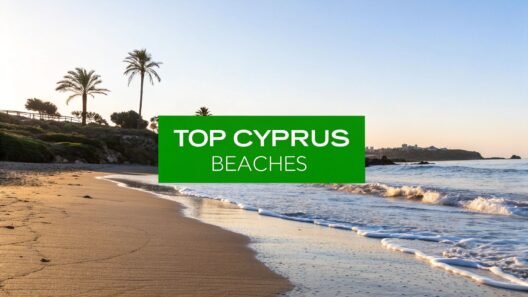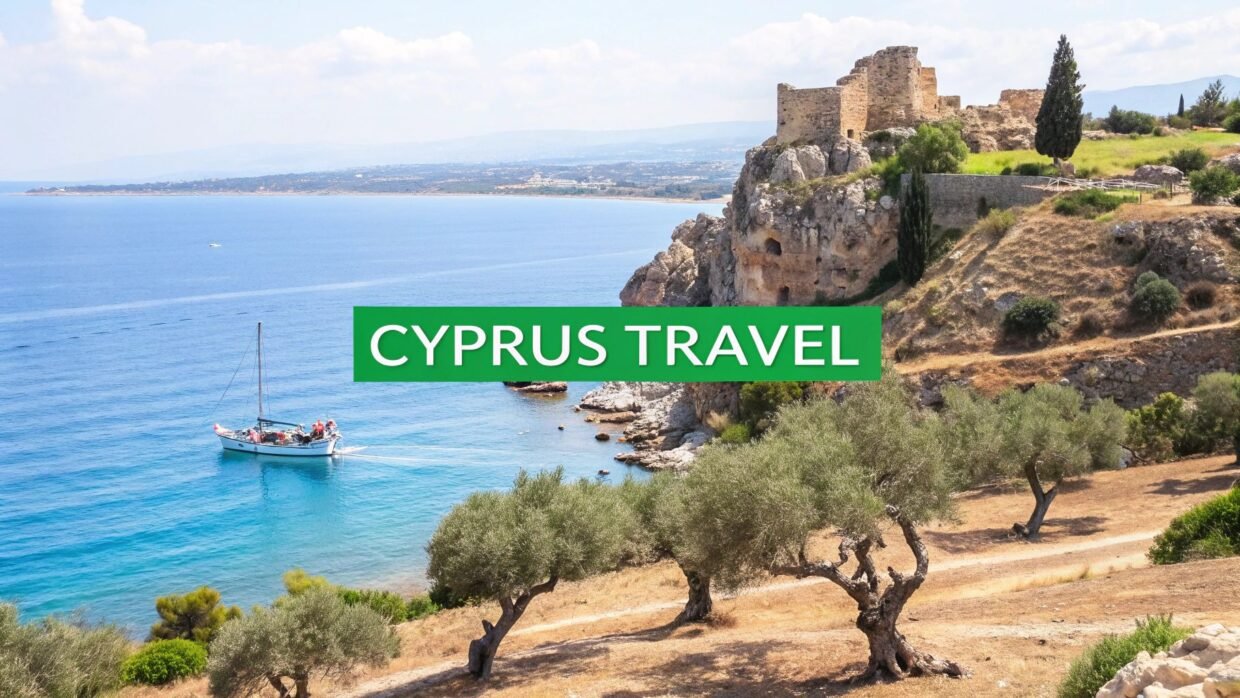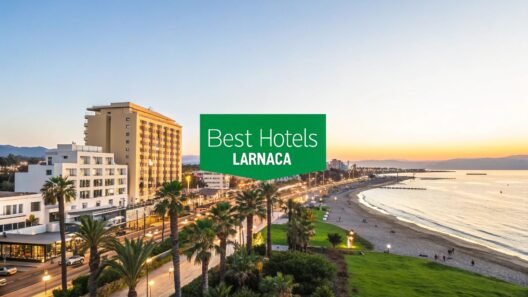Welcome to your ultimate Cyprus travel guide! If you're dreaming of a Mediterranean escape that has it all, you've come to the right place. Cyprus is a real gem, offering a spectacular mix of sun-drenched beaches, ancient history, and a culture so vibrant you can feel it in the air.
Picture this: you could be soaking up the sun near the mythical birthplace of Aphrodite in the morning, then wandering through stunning Roman mosaics by the afternoon. It's a living museum where history is just a stone's throw from the shoreline.
Why Cyprus Is Your Perfect Holiday Destination
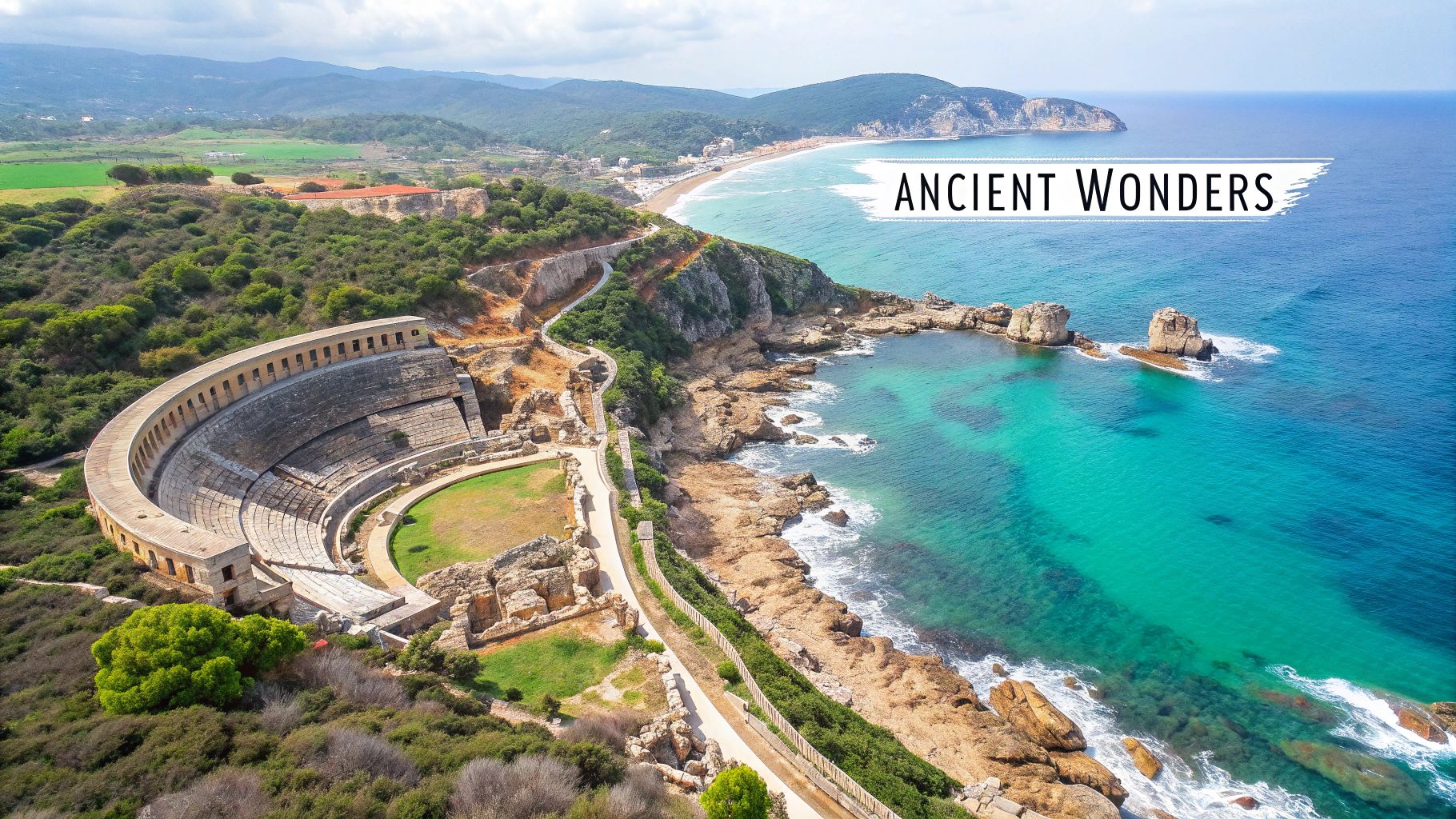
So, what makes Cyprus so special? It's the incredible blend of experiences that caters to just about everyone. It’s an island where myth and modernity don't just coexist; they mingle beautifully. One moment you might find yourself lost in thought among the ruins of Kourion, an ancient city-kingdom, and the next you're sipping a world-class cocktail at Limassol's chic marina. This wonderful contrast is the true heart of Cyprus.
For British holidaymakers, the island feels like a home away from home. English is spoken everywhere, they drive on the left, and you’ll find a comforting sense of familiarity that makes settling in a breeze. It lets you relax from the moment you step off the plane. This strong link isn't just a feeling; the UK has long been the number one source of visitors to the island.
As one of the world's most popular destinations per capita—ranking 6th globally—tourism is a huge part of the Cypriot economy. The island's historical ties to the UK and the widespread use of English only add to its appeal for British travellers.
Of course, we have to talk about the beaches. The coastline is a paradise for sun-seekers, with everything from buzzing, fully-serviced beaches to quiet, hidden coves waiting to be discovered. Whether you’re after the family-friendly sands of Protaras or the wild, rugged beauty of the Akamas Peninsula, there’s a perfect spot of sand calling your name.
If waking up to the sound of the waves is your idea of heaven, check out some of the best beach hotels in Cyprus to find your dream seaside escape.
To help you get your bearings, here's a quick look at what each corner of the island has to offer.
Cyprus At A Glance Your Quick Holiday Planner
This little table gives you a snapshot of Cyprus's main regions and what they're famous for. It's the perfect starting point to help you decide where to base your adventures.
| Region | Best For | Top Attraction |
|---|---|---|
| Paphos | History Buffs & Couples | Tomb of the Kings & Aphrodite's Rock |
| Ayia Napa & Protaras | Beach Lovers & Families | Nissi Beach & Cape Greco National Park |
| Limassol | Cosmopolitan Travellers | Limassol Marina & Kourion Archaeological Site |
| Troodos Mountains | Nature Lovers & Hikers | Kykkos Monastery & Mount Olympus |
| Nicosia | Culture & History Seekers | The Divided Capital & The Walled Old City |
With this in mind, you can start to piece together an itinerary that’s perfectly suited to your travel style.
Discovering the Diverse Regions of Cyprus
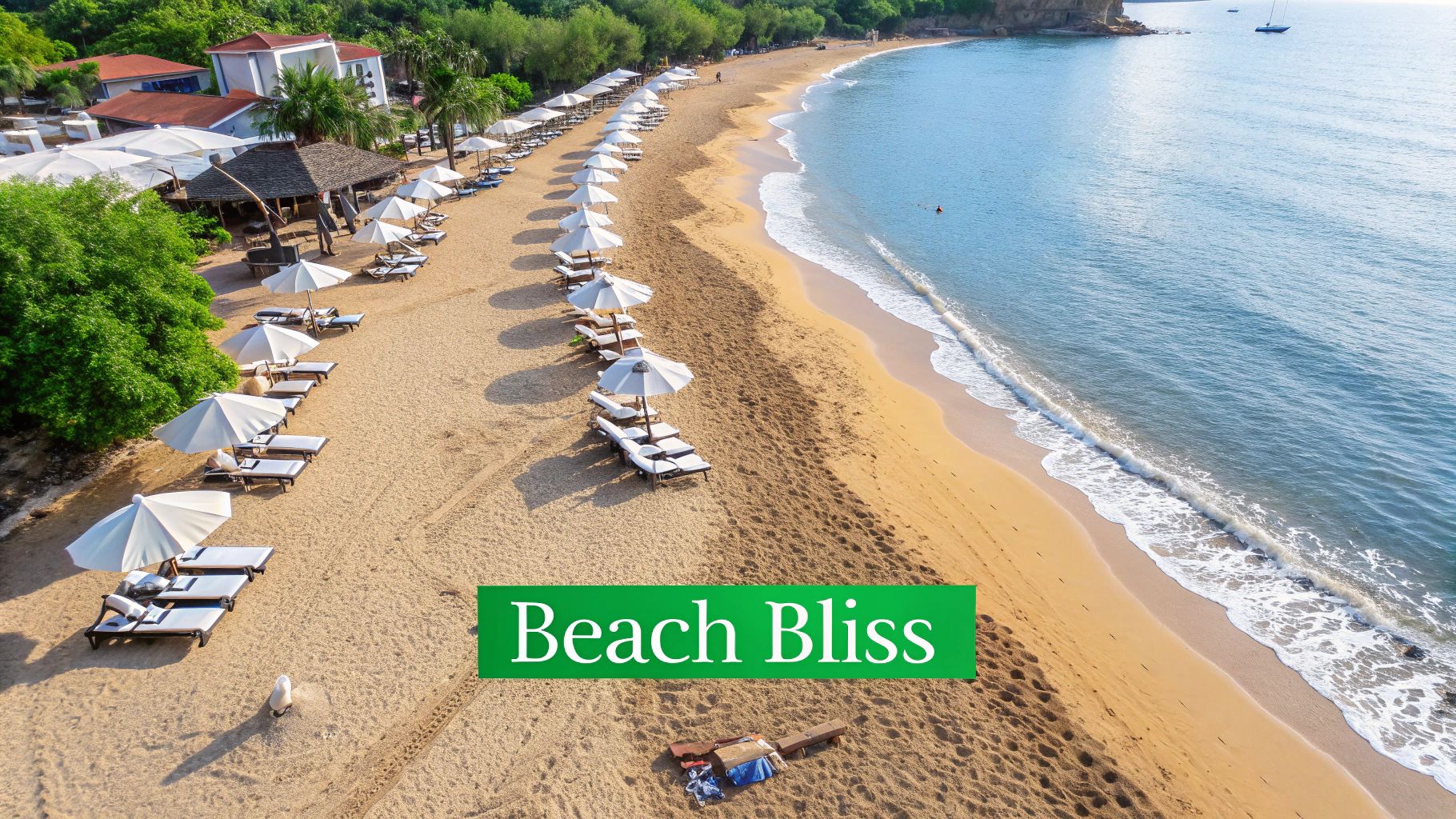
Figuring out where to base yourself in Cyprus can feel like a big decision. That's because it is. The island isn't just one homogenous holiday spot; it's a rich tapestry of completely different regions, each with its own vibe and personality. This part of our Cyprus travel guide is here to give you the lay of the land, helping you find the spot that feels just right for you.
From sun-bleached ancient ruins and buzzing modern cities to quiet mountain villages that seem lost in time, your home base will shape your entire trip. Let's take a tour through the island's most loved areas to discover which one is calling your name.
Paphos: Where History and Romance Meet
Paphos is, without a doubt, the historical heart of Cyprus. The entire town is a UNESCO World Heritage site, and it feels like it. Ancient stories are practically etched into the stones here, from the mind-blowing floor mosaics of Roman villas to the haunting Tomb of the Kings, carved straight from the bedrock. It's a place that just breathes history and romance.
The town itself has two distinct personalities. There's Kato Paphos (Lower Paphos), which is the lively harbour area packed with hotels and restaurants right on the water. Then you have Ktima Paphos (Upper Paphos), the charming old town, which offers a more authentic, local atmosphere.
- Best For: History lovers, couples looking for a romantic setting, and anyone who wants a holiday that mixes culture with serious relaxation.
- Don't Miss: The archaeological park with its world-famous mosaics, the mythical Aphrodite's Rock, and a slow walk along the harbour as the sun goes down.
Ayia Napa and Protaras: The Kingdom of Sun and Sand
Head to the island's far eastern tip, and you'll find the sun-worshipper's paradise of Ayia Napa and Protaras. This stretch of coast is legendary for having some of Europe's most spectacular beaches, boasting powder-soft white sand and water so clear and blue it almost doesn't look real. Nissi Beach in Ayia Napa is famous for its lively party scene, while Fig Tree Bay in Protaras is perfect for families seeking a more chilled-out vibe.
But don't be fooled by Ayia Napa's party reputation. The area offers so much more, like the stunning Cape Greco National Forest Park. Its dramatic sea caves and rugged cliffs are a world away from the beach clubs.
If your idea of a perfect holiday is built around the sea, this eastern coast is for you. It's the kind of place where the day's toughest choice is whether to swim, sunbathe, or order another cocktail without leaving your lounger.
Limassol: The Cosmopolitan Heartbeat
Limassol (or Lemesos) is Cyprus's most vibrant and modern city. It manages to perfectly blend the energy of a bustling urban hub with the laid-back feel of a seaside resort. You'll see the sleek, modern marina filled with superyachts and chic restaurants sitting comfortably next to a character-filled old town, complete with a medieval castle and twisting alleyways.
This is a city that buzzes with life, day and night. It has a fantastic food scene, great shopping, and a long coastal path perfect for a walk. Limassol attracts a more sophisticated crowd—from digital nomads to holidaymakers who appreciate a faster pace.
- Best For: Travellers who want a bit of everything: beaches, nightlife, culture, and incredible food. It's also a great central base for exploring the rest of the island.
- Don't Miss: The magnificent Kourion Archaeological Site just outside the city, getting lost in the renovated old town, and enjoying an evening at the glamorous Limassol Marina.
Nicosia: The World's Last Divided Capital
For an experience you won't find anywhere else, you have to go inland to Nicosia (Lefkosia). This isn't your typical beach resort; it's a real, working city with a deep and complex history. Nicosia holds the unique and poignant title of being the last divided capital in the world, split by the UN-patrolled "Green Line" that separates the Republic of Cyprus from the Turkish-occupied north.
Walking through the old city's Venetian walls and crossing the checkpoint on Ledra Street is a surreal and powerful moment. You can genuinely experience two distinct cultures in a single afternoon. The southern side has a modern European feel with its cafes and boutiques, while the northern side instantly immerses you in the atmosphere of a Turkish bazaar, crowned by the stunning Büyük Han inn.
The Troodos Mountains: An Escape to Nature
When the heat of the coast gets too much, the Troodos Mountains are the perfect antidote. This vast mountain range is the island's green lung, offering a world of cool, pine-scented air, cascading waterfalls, and timeless stone villages where life moves at a much gentler pace.
Up here, you can explore ancient painted churches (many are UNESCO sites), hike to the top of Mount Olympus, and experience true Cypriot hospitality in a family-run taverna. Come winter, the peaks are even covered in snow, transforming into a small ski resort!
- Ideal Traveller: Nature lovers, hikers, and anyone curious to see a more traditional, authentic side of Cyprus away from the main tourist hubs.
- Top Experience: Visiting the famous and opulent Kykkos Monastery, exploring the impossibly charming village of Lofou, and sampling local wine at a small, family-owned winery.
Crafting Your Perfect Cyprus Itinerary
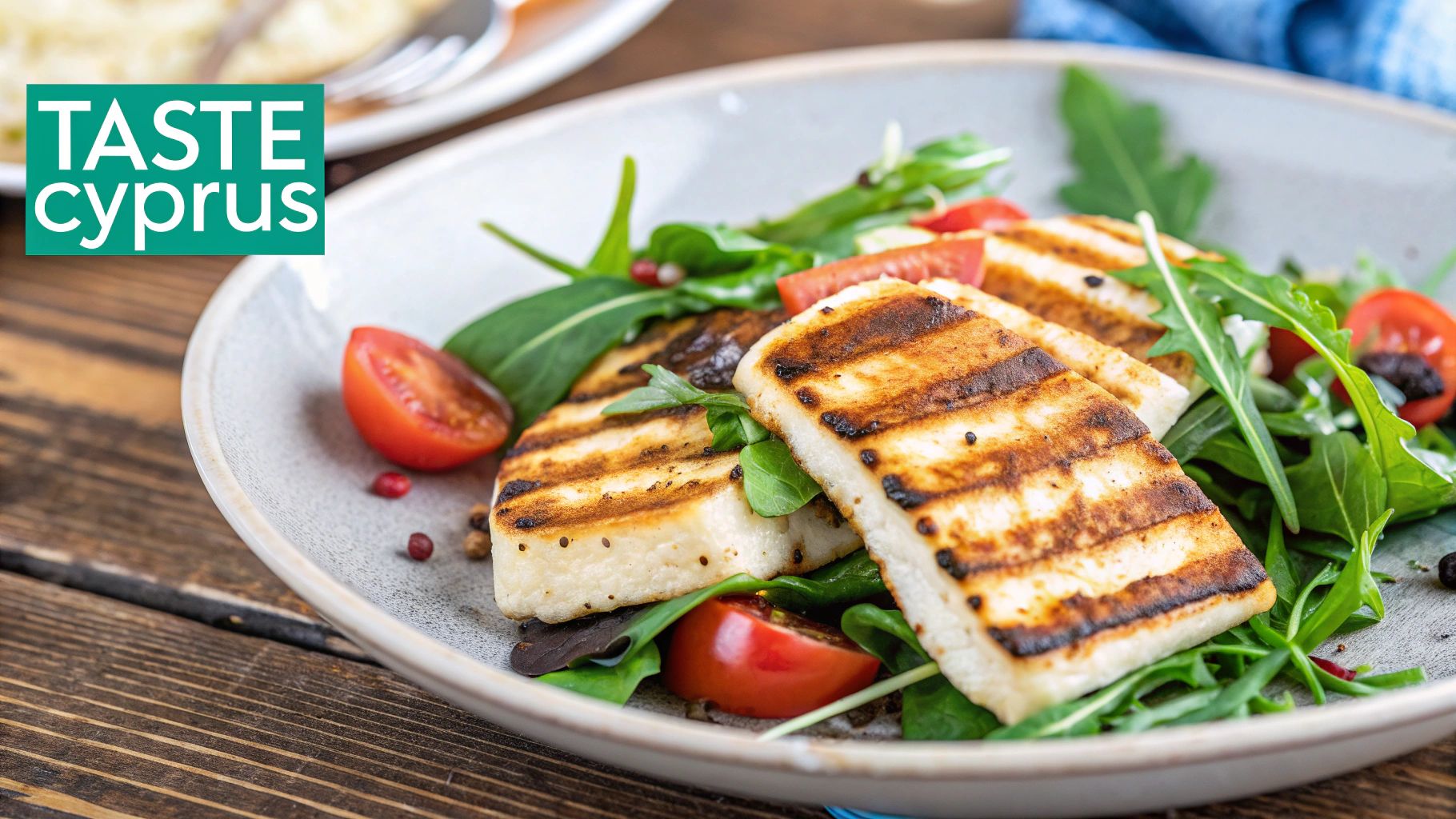
So, you've got a feel for the different regions of Cyprus. Now for the fun part: piecing it all together into an actual trip. It's easy to get bogged down in the details, but try to think of your itinerary less as a strict schedule and more as a flexible blueprint for your adventure.
One of the best things about Cyprus is its size. It’s compact enough that you can experience a surprising amount of variety—from ancient ruins to mountain villages and sun-drenched beaches—all in a single trip.
Here, we've sketched out three different sample itineraries. Feel free to follow one exactly or, better yet, pick and choose the bits that excite you most to create a holiday that’s uniquely yours.
The One-Week Coastal Explorer
This is the classic Cyprus experience, perfect for first-timers. It's a grand tour of the island's most famous coastal sights, weaving together ancient history with sparkling modern marinas. You'll go from the mythical birthplace of a goddess to the buzz of a contemporary resort town.
- Days 1-3: Paphos & Akamas: Make Paphos your base for the first few nights. Spend day one wandering through the incredible UNESCO-listed Archaeological Park and the Tomb of the Kings. The next day, make the pilgrimage to the legendary Aphrodite's Rock before heading out to the rugged Akamas Peninsula to see the stunning Blue Lagoon.
- Days 4-5: Limassol & Kourion: Drive east along the coast to Limassol. Get your bearings by exploring the chic marina and wandering through the historic old town. The following day, visit the magnificent Kourion Archaeological Site—its Greco-Roman theatre, perched above the sea, is an unforgettable sight.
- Days 6-7: Larnaca & Cape Greco: For your final leg, continue to Larnaca. Stroll along the Finikoudes promenade and visit the beautiful Church of Saint Lazarus. On your last full day, take a short drive to Cape Greco National Forest Park to marvel at the sea caves and swim in the crystal-clear waters near Ayia Napa.
Family Fun In The Sun
If you're travelling with little ones, this itinerary is for you. It centres on the calm, clear waters and family-friendly vibe of the eastern coast. The goal here is simple: maximum fun and relaxation with minimum travel stress.
Cyprus is just fantastic for families. You've got safe, Blue Flag beaches and more than enough to keep children of all ages entertained. This plan is all about sun, sand, and smiles.
A Day-by-Day Family Adventure
- Days 1-4: Protaras Base: Settle into a hotel or villa in Protaras, a town famous for its gentle, shallow waters. Your days here are for building sandcastles at Fig Tree Bay and maybe trying some fun water sports. For a change of pace, the Ocean Aquarium is an easy and engaging afternoon out.
- Days 5-6: Ayia Napa Exploration: Take a day trip over to Ayia Napa. For a real thrill, spend the day at WaterWorld Themed Waterpark, one of the biggest in Europe. On another day, opt for a more relaxed pirate-themed boat trip from the harbour—always a hit with the kids.
- Day 7: Departure from Larnaca: Enjoy one last morning on the beach before the easy 45-minute drive back to Larnaca Airport for your flight home.
The Culture And Mountains Escape
Ready to see a different side of Cyprus? This itinerary trades some beach time for the urban energy of the capital and the quiet beauty of the Troodos Mountains. It's a journey into the true heart and soul of the island.
This kind of trip shows why so many visitors, especially from the UK, come back again and again. In fact, the relationship between the UK and Cyprus is incredibly strong. By 2023, tourist arrivals from the United Kingdom had bounced back to nearly 1.3 million, cementing the UK’s place as the island's biggest tourism market. It highlights a deep-rooted connection that goes back decades.
This plan offers a completely different perspective on what a Cypriot holiday can be.
- Days 1-2: Nicosia, The Divided Capital: Start your adventure in Nicosia. You'll want time to explore the historic Venetian walls, get lost in the old town's narrow lanes, and experience the unique history of crossing the Green Line into the northern part of the city.
- Days 3-5: The Troodos Mountains: Pick up a hire car and head for the hills. Find a traditional guesthouse in a village like Lofou or Kakopetria. Spend these days hiking scenic nature trails, discovering UNESCO-listed painted churches, and stopping at local wineries to sample the famous Commandaria wine.
- Days 6-7: Relax in a Coastal Town: After your mountain escape, drive back down towards the coast. Spend your final two nights unwinding in a relaxed town like Pissouri or Polis, enjoying the sea breeze before heading home.
Think of these itineraries as a starting point. Mix them, match them, and make them your own. For a deeper dive into planning, check out our comprehensive guide to building your perfect https://saycyprus.com/cyprus-travel-itinerary/.
How to Get Around Cyprus Like a Local
One of the first questions I always get asked is about the best way to get around Cyprus. Your choice of transport can genuinely make or break your trip, dictating whether you’re tethered to your resort or out there discovering the island’s real hidden treasures.
Think of it like choosing the right pair of shoes for a hike. Pick well, and you’ll have the freedom to explore wherever you want, comfortably and confidently. The wrong choice can leave you feeling stuck, frustrated, and missing out. Let’s break down your options so you can navigate this beautiful island with total ease.
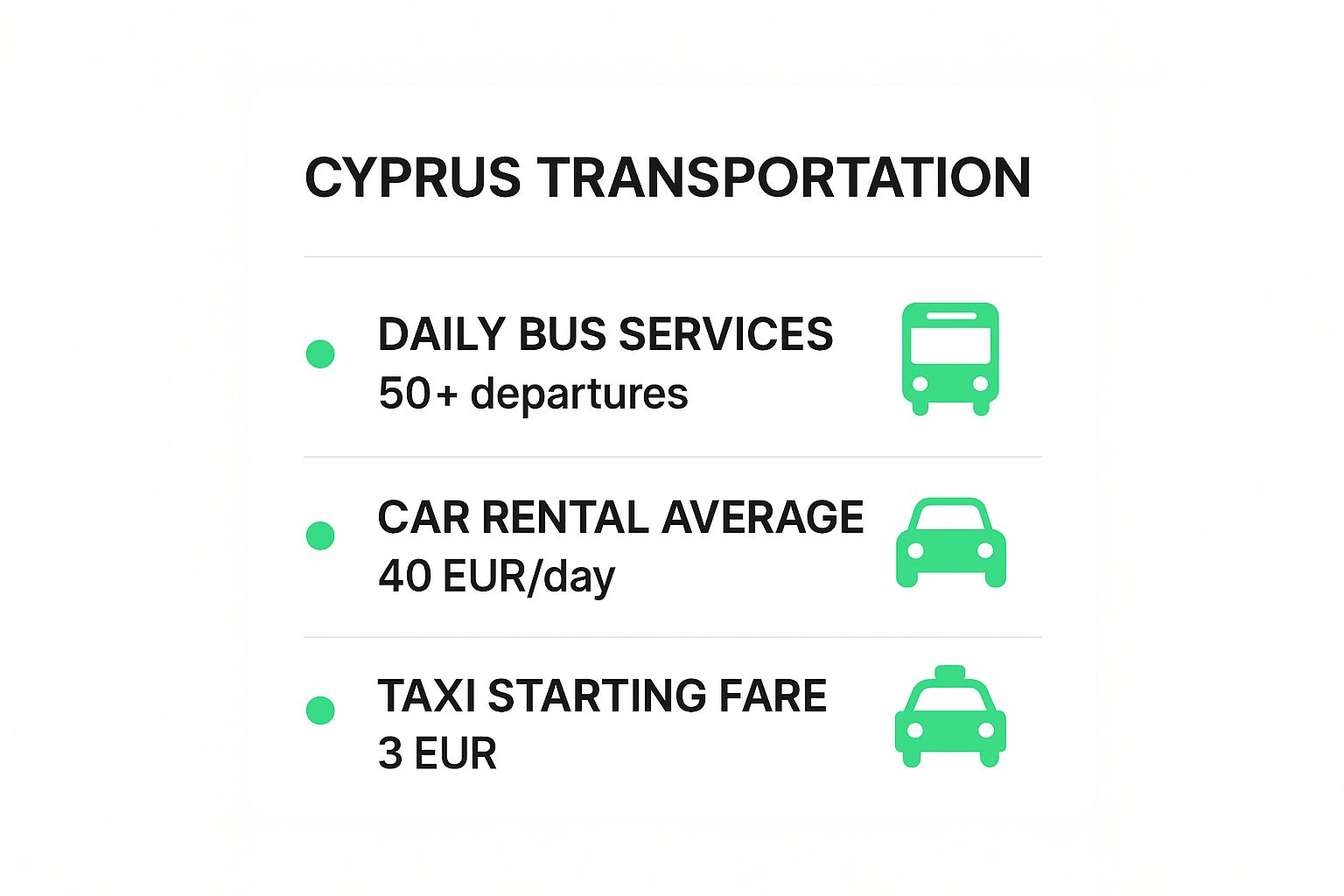
As you can see, hiring a car gives you fantastic value if you plan to explore daily, but the bus network is a brilliant, budget-friendly alternative for hopping between the main towns.
Hiring a Car for Ultimate Freedom
For the vast majority of visitors, hiring a car is hands-down the best way to experience Cyprus. It gives you complete freedom to explore on your own schedule, from the sun-drenched beaches along the coast to the cool, pine-scented Troodos Mountains. Public transport just won't get you to those secluded coves or traditional, time-warp villages.
The great news, especially for anyone coming from the UK, is that Cypriots also drive on the left-hand side of the road. On top of that, the road signs are in both Greek and English, making the whole experience feel familiar and far less intimidating than driving in mainland Europe.
Renting a car is also surprisingly good value. You can often find deals for as little as €20-€40 per day, particularly if you book ahead or travel outside the peak summer months. All the major international rental companies have desks at both Larnaca (LCA) and Paphos (PFO) airports, so picking up and dropping off your car is a breeze.
Understanding the Bus Network
If you're on a tighter budget or simply prefer not to drive, Cyprus has a surprisingly decent intercity bus network connecting the main towns. These modern, air-conditioned green buses are very reliable and a fantastic option for day trips between the major hubs.
With over 50 daily departures on key routes, the intercity buses are a cost-effective and straightforward way to travel between Paphos, Limassol, Larnaca, and Nicosia. A single journey typically costs just a few Euros, offering fantastic value.
It's important to know their limits, though. While the buses are brilliant for travelling between cities, they aren’t much use for exploring within a region. They won’t take you to that remote monastery high in the hills or the hidden beach you spotted on a postcard. Think of them as the island's main arteries, not the smaller veins that lead to the best-kept secrets.
Taxis and Ride-Sharing Services
Taxis are everywhere in the tourist areas and at the airports, but they can get pricey for longer journeys. They are metered, with a starting fare of around €3-€4, and the cost quickly adds up with distance. They’re best for short hops—like getting from your hotel to a local restaurant—or for travelling late at night when the buses have stopped running.
For airport transfers, you’ll almost always save money by pre-booking a private transfer online rather than grabbing a cab on arrival. As for ride-sharing, services like Bolt and Uber are active in Cyprus, but their availability can be patchy outside the bigger cities like Nicosia and Limassol. It's always a good idea to compare the app's quote with the local taxi fares before you book.
Cyprus Transport Options Compared
To help you figure out what’s best for your trip, I've put together a quick comparison of the main ways to get around. This should make the decision a whole lot easier.
| Transport Method | Best For | Average Cost | Pros | Cons |
|---|---|---|---|---|
| Rental Car | Ultimate flexibility and exploring remote areas | €20-€40 per day | Freedom to go anywhere; cost-effective for groups and families. | Requires a confident driver; parking can be tricky in older towns. |
| Intercity Bus | Budget travel between major cities | €4-€7 per trip | Extremely cheap and reliable for city-to-city travel. | Limited routes; doesn't serve villages or remote sights. |
| Taxi/Ride-Share | Short trips, airport transfers, and late-night travel | Varies (e.g., €15 for a 10-min ride) | Door-to-door service; available around the clock in tourist areas. | Can become very expensive for long distances or frequent use. |
Ultimately, the best choice depends on your travel style. A car offers unparalleled freedom, while buses and taxis provide convenient solutions for specific needs. Mixing and matching can often be the smartest approach
Top Tips for British Travellers Heading to Cyprus
For many Brits, jetting off to Cyprus feels a bit like visiting a home away from home, but knowing a few local details can transform a good holiday into a great one. Think of this as your friendly insider briefing, packed with practical advice to help you get the most out of your time on the island. We’ll cover everything from currency to local customs, so you can travel with total confidence.
The strong bond between the UK and Cyprus is clear the moment you step off the plane. Brits are, by a long shot, the biggest group of holidaymakers here. To put it in perspective, in June 2025 alone, a massive 181,610 visitors arrived from the UK, making up over 36.4% of all tourists that month. This isn't just a fleeting trend; it’s a long-standing connection built on more than just sunshine and beautiful beaches.
Getting the Practicalities Sorted
Let’s get the simple, but essential, stuff out of the way first. As part of the EU, Cyprus uses the Euro (€). You'll find that credit and debit cards are accepted almost everywhere in resorts, restaurants, and bigger shops. Still, it’s always a smart move to have a bit of cash on you for those charming little tavernas, market stalls, or for leaving a tip.
Here’s another bit of good news: Cyprus uses the Type G plug socket. That’s the same three-pin plug we use back in the UK, so you can leave that bulky universal adaptor at home. That's more space in the suitcase for souvenirs!
One of the first things people ask is when to go. For that perfect beach holiday, you can’t beat June and September. The sun is glorious, but you miss the peak intensity of July and August. If you're more into exploring ancient sites and hiking, the milder weather in April, May, and October is absolutely ideal.
Embracing Local Life & Culture
Cypriots are famous for their incredible hospitality, a concept they call philoxenia. Making a small effort with local customs really does go a long way and will be met with warm smiles. Trying out a few Greek phrases is a great way to break the ice.
- Yassas (YAH-sas): A polite "hello" to use with anyone.
- Kalimera (kah-lee-MER-ah): Good morning.
- Efcharisto (eff-kah-rees-TOH): Thank you.
- Parakalo (pah-rah-kah-LOH): Please or You're welcome.
When it comes to eating out, remember that meals are meant to be slow, relaxed, and sociable. While tipping isn't mandatory, it's certainly appreciated. Rounding up the bill or leaving 5-10% for great service is standard practice. To truly dive into the local culture, you have to try a traditional meze – a fantastic feast of small, flavourful dishes. To get your mouth watering, check out our guide to the must-try traditional food in Cyprus.
Understanding the North-South Divide
A unique part of any trip to Cyprus is navigating the island’s political landscape. The island is divided by the "Green Line," which separates the Republic of Cyprus (the south) from the Turkish-controlled north. For holidaymakers, crossing between the two is surprisingly simple at one of the official checkpoints, like the well-known Ledra Street crossing in the heart of Nicosia.
You’ll just need to show your passport to cross, but they don't stamp it. It’s a very straightforward process that offers a fascinating opportunity to see two distinct cultures in a single day. One crucial point to remember: car rental insurance from the south generally won't cover you in the north. If you plan to drive across, you'll likely need to sort out separate insurance at the border. As always, it’s wise to check the latest official travel advice from the UK government before you fly.
Your Cyprus Questions, Answered
Even the most experienced travellers have a few questions before jetting off somewhere new. This is the part of our guide where we tackle some of the most common queries we get from British holidaymakers heading to Cyprus. We’ll cover everything from budgets to practical bits and pieces, making sure you feel completely ready for a brilliant trip.
Is Cyprus an Expensive Place for a Holiday?
This is the big one, isn't it? The honest answer is: Cyprus is whatever you make it. It can be a seriously luxurious escape or a wonderfully affordable getaway.
Of course, a week in a five-star Limassol resort with fine dining every night is going to cost a fair bit. But that's only one side of the coin. It's just as easy to have an incredible time without breaking the bank. Think of it like a day out shopping – you can head for the designer boutiques or find amazing, stylish pieces on the high street. In Cyprus, you can stay in charming, family-run guesthouses, eat phenomenal meals at local tavernas for a fraction of the resort price, and hop on the affordable intercity buses to explore.
Generally speaking, Cyprus is more affordable than other popular Med spots like the Amalfi Coast or the south of France. For a comfortable, mid-range holiday, a daily budget of around €80-€120 per person is a realistic starting point. That should comfortably cover your accommodation, food, and a few activities.
If you really want to stretch your pounds, look at visiting in the shoulder seasons (April-May or September-October). You’ll find that prices for flights and places to stay take a very welcome dip.
What’s the Best Month to Go for Good Weather?
Cyprus is blessed with one of the warmest climates in Europe and gets a staggering 300+ days of sunshine a year. So, there really isn't a "bad" time to visit, but the "best" time really comes down to what you want from your holiday.
-
For Peak Sunshine (June – August): If you're chasing guaranteed heat and long, lazy days on the beach, this is your time. Temperatures soar, often pushing well into the 30s (°C). It's perfect for swimming and sunbathing, but it can be a bit intense for a full day of sightseeing.
-
For the Perfect Balance (May, June, September & October): We think these are the sweet spot months. The weather is just gorgeous – beautifully warm and sunny, with temperatures usually hovering in the very comfortable mid-to-high 20s. The sea has warmed up nicely for a dip, but the heat isn’t overwhelming, making it ideal for both relaxing and exploring.
-
For Exploring & Hiking (March, April & November): The spring and early autumn months bring milder weather, which is absolutely perfect for getting active. Think hiking in the Troodos Mountains or wandering through ancient ruins without working up too much of a sweat.
Is It Safe to Drink the Tap Water?
Yes, the tap water in the Republic of Cyprus is perfectly safe to drink. It's properly treated and meets all the required EU standards, so you don't need to worry about it making you ill.
That said, you'll find many locals and long-term expats prefer to drink bottled water. This isn't for safety reasons, but purely down to taste. The tap water can be quite high in minerals, giving it a flavour that some people just aren't keen on. For a week or two on holiday, it’s absolutely fine for drinking, brushing your teeth, or making a brew. If you know you're sensitive to changes in water, though, bottled water is cheap and available everywhere.
Do I Need a Visa for Cyprus with a UK Passport?
Nope, you don't. For British passport holders heading over for a holiday, visiting Cyprus is very straightforward. As a UK citizen, you can travel to Cyprus for tourism, to visit family, or for business for up to 90 days in any 180-day period without a visa.
This falls under the standard Schengen Area rules that now apply to UK citizens travelling to most EU countries. Just make sure your passport is valid for your entire trip and was issued less than 10 years before you travel. It’s always smart to have a quick look at the latest official travel advice on the UK government website before you fly, but for a standard holiday, you're good to go.
At SayCyprus, we're passionate about helping you discover the real heart of this incredible island. We believe that with a little insider knowledge, your trip can be more than just a holiday—it can be an unforgettable adventure. Explore our other guides and articles at https://www.saycyprus.com to start planning your perfect Cypriot escape.








